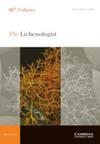Marchantiana pyramus, M. ramulicola and Austroplaca thisbe (Teloschistaceae, lichenized Ascomycota) - 来自巴塔哥尼亚南部的三种新树枝地衣
IF 1.4
4区 生物学
Q4 MYCOLOGY
引用次数: 0
摘要
摘要:本文报道了巴塔哥尼亚南部的三种细枝地衣属植物:含有细枝地衣的Marchantiana pyramus sp. nov.,含有细枝地衣,由于大黄素的优势含量而呈橙色;含有细枝地衣的M. ramulicola sp. nov.,含有细枝橄榄地衣,并具有优势组份;Marchantiana subpyracea, M. epibrya和M. queenslandica是迄今为止仅在新西兰和澳大利亚发现的物种的新组合。圆极Blastenia在巴塔哥尼亚非常常见,Marchantiana asserigena首次在南半球(即福克兰群岛)被记录下来。在这里用三个基因对Marchantiana属进行了分析,结果表明与吉村属(Yoshimuria)密切相关;虽然表现为副系,但不能排除单系起源。形态、生态和分布支持单系处理,因此,Marchantiana被视为单系处理。本文章由计算机程序翻译,如有差异,请以英文原文为准。
Marchantiana pyramus, M. ramulicola and Austroplaca thisbe (Teloschistaceae, lichenized Ascomycota) – three new twig lichens from southern Patagonia
Abstract Three twig-growing lichen species belonging to the family Teloschistaceae from southern Patagonia are described as new to science: Marchantiana pyramus sp. nov., with minute apothecia, orange due to dominant content of emodin, M. ramulicola sp. nov., with minute olive apothecia with dominant parietin and Austroplaca thisbe sp. nov., with clear yellow apothecia also with dominant parietin. Marchantiana subpyracea , M. epibrya and M. queenslandica are new combinations for species which, so far, are known only from New Zealand and Australia. Blastenia circumpolaris is shown to be very common in Patagonia and Marchantiana asserigena is documented for the first time from the Southern Hemisphere, viz. the Falkland Islands. The genus Marchantiana is analyzed here using three genes and is shown to be closely related to Yoshimuria ; although appearing as paraphyletic, a monophyletic origin cannot be ruled out. Morphology, ecology and distribution support a monophyletic treatment and Marchantiana is therefore treated as such.
求助全文
通过发布文献求助,成功后即可免费获取论文全文。
去求助
来源期刊

Lichenologist
生物-真菌学
CiteScore
2.90
自引率
14.30%
发文量
23
审稿时长
6.0 months
期刊介绍:
The Lichenologist is the premier scientific journal devoted exclusively to the study of lichens worldwide. As the leading forum for the dissemination of new concepts and topical reviews, The Lichenologist reaches more scientists concerned with the study of lichens and lichen symbionts than any other single journal. All aspects of lichenology are considered including systematics and phylogenetics; molecular biology; ultrastructure, anatomy and morphology; secondary chemistry, effects of pollutants and use as bioindicators; biogeography. In addition to standard length research papers, the journal also publishes Short Communications and Book Reviews. A monthly issue may occasionally be devoted to papers deriving from a symposium.
 求助内容:
求助内容: 应助结果提醒方式:
应助结果提醒方式:


